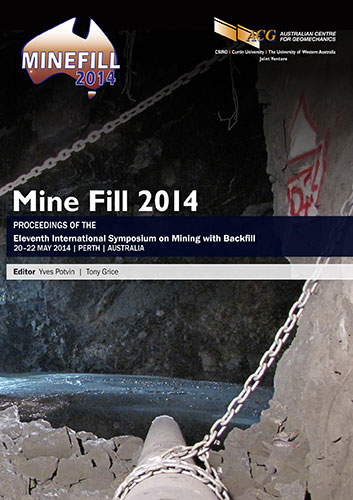Transition from discontinuous to continuous paste filling at Cannington Mine

|
Authors: Li, J; Ferreira, JV; Le Lievre, T |
DOI https://doi.org/10.36487/ACG_rep/1404_30_Li
Cite As:
Li, J, Ferreira, JV & Le Lievre, T 2014, 'Transition from discontinuous to continuous paste filling at Cannington Mine', in Y Potvin & T Grice (eds), Mine Fill 2014: Proceedings of the Eleventh International Symposium on Mining with Backfill, Australian Centre for Geomechanics, Perth, pp. 381-394, https://doi.org/10.36487/ACG_rep/1404_30_Li
Abstract:
Cannington Mine is an underground multi-metal mine that uses the sublevel open stoping mining method. The majority (>95%) of the void created by this mining method is filled with paste, a mixture of process tailings, cement and water. For each void to be filled all level openings are sealed with a fibrecrete fill wall. The cemented paste fill allows for a continuous retreating sequence between primary and secondary (or tertiary) stopes. Backfilling is an integral part of the mining cycle; consequently a reliable and productive paste fill system is required with integration between both surface infrastructure and the underground paste filling strategy. To mitigate the risk of fill wall failure due to the pressure imposed on each fill wall by uncured paste fill a discontinuous filling strategy (or stop and cure process) was used at Cannington Mine. When the paste fill level in a stope was passing a level opening with a fill wall present, paste filling was stopped or slowed to allow the paste fill to cure. This discontinuous paste filling strategy caused 15-20% of paste fill downtime, each stop and cure usually involved changing to fill an alternate stope and required fill line flushing to clear paste from reticulation network after completion of and before starting up each fill run, and fill line changing. A project was established in mid 2011 to investigate the effects of continuously paste filling behind a fill wall. The project involved numerical modelling of the strength of fibrecrete fill walls with various dimensions (width, height and thickness), correlated data gathered from in situ fill wall pressure monitoring, using pressure cells with varying vertical rate of rise, and different paste fill cement contents. The data analysis led to operational procedure updates allowing continuous paste filling and the establishment of a wall thickness design tool. Project outcomes saw continuous filling behind both arched and flat fibrecrete fill walls, which resulted in a 15% reduction in paste fill down time; it allowed a reduction in fibrecrete fill wall thickness, which reduced fibrecrete consumption by 30% on average; and led to a reduction in paste fill line changes, which increased paste crew productivity, and decreased the frequency of cold joints caused by flushing in paste fill masses. A continuous paste fill strategy was successfully implemented and has been applied without incident since project completion in early 2012.
References:
Bawden, WF 2010, ‘Field instrumentation of paste backfill’, Keynote speech presentation for the Eastern Australia Ground Control Group workshop, Brisbane, May 2010.
Bernard, S 2006, Early age fibre reinforced shotcrete lining capacity for BHP Billiton – Cannington, a consulting report from Technology in Structural Engineering P/L, Penrith, no. 163.
Bloss, M & Revell, MB 2000, ‘Cannington paste fill system – achieving demand capacity’, in G Chitombo (ed.), Proceedings of MassMin 2000, Australasian Institute of Mining and Metallurgy, Melbourne, pp. 713-20.
Grabinsky, MW & Bawden, WF 2007, ‘In situ measurements for geomechanical design of cemented paste backfill systems’, in FP Hassani & JF Archibald (eds), Proceedings of the 9th International Symposium on Mining with Backfill, Canadian Institute of Mining, Metallurgy and Petroleum, Westmount, paper #2456, on CD-ROM.
Helinski, M, Fahey, M & Fourie AB 2007, ‘An effective stress approach to modelling mine backfill’, in FP Hassani & JF Archibald (eds), Proceedings of the 9th International Symposium on Mining with Backfill, Canadian Institute of Mining, Metallurgy and Petroleum, Westmount, paper #2479, CD-ROM.
Hughes, PB, Pakalnis, R, Hitch & Corey, G 2010, ‘Composite paste barricade performance at Goldcorp Inc. Redlake Mine, Ontario, Canada’, International Journal of Mining, Reclamation and Environment, vol. 24, pp. 138-50.
Li, J, Todd, JK & Campbell, A 2011, ‘Ground support design and application for developing in paste fill at BHP Billiton – Cannington Mine’, Proceedings of the 11th AusIMM Underground Operators’ Conference, The Australasian Institute of Mining and Metallurgy, Canberra, pp. 201-6.
Revell, MB, Helinski, M, Wines, D & Sainsbury, DP 2009, ‘BHPB Cannington sprayed fibrecrete bulkhead design’, technical consulting report to Cannington mine from Revell Resources Pty Ltd and Itasca Australia Pty Ltd.
Sainsbury, DP & Revell, MB 2007, ‘Advancing paste fill bulkhead design using numerical modelling’, CIM Bulletin, vol. 100, no. 1103, paper #25.
Yumlu, M & Guresci, M 2007, Paste backfill bulkhead failures and pressure monitoring at Cayeli Mine, CIM Bulletin, vol. 100, no. 1103, paper #22.
© Copyright 2025, Australian Centre for Geomechanics (ACG), The University of Western Australia. All rights reserved.
View copyright/legal information
Please direct any queries or error reports to repository-acg@uwa.edu.au
View copyright/legal information
Please direct any queries or error reports to repository-acg@uwa.edu.au